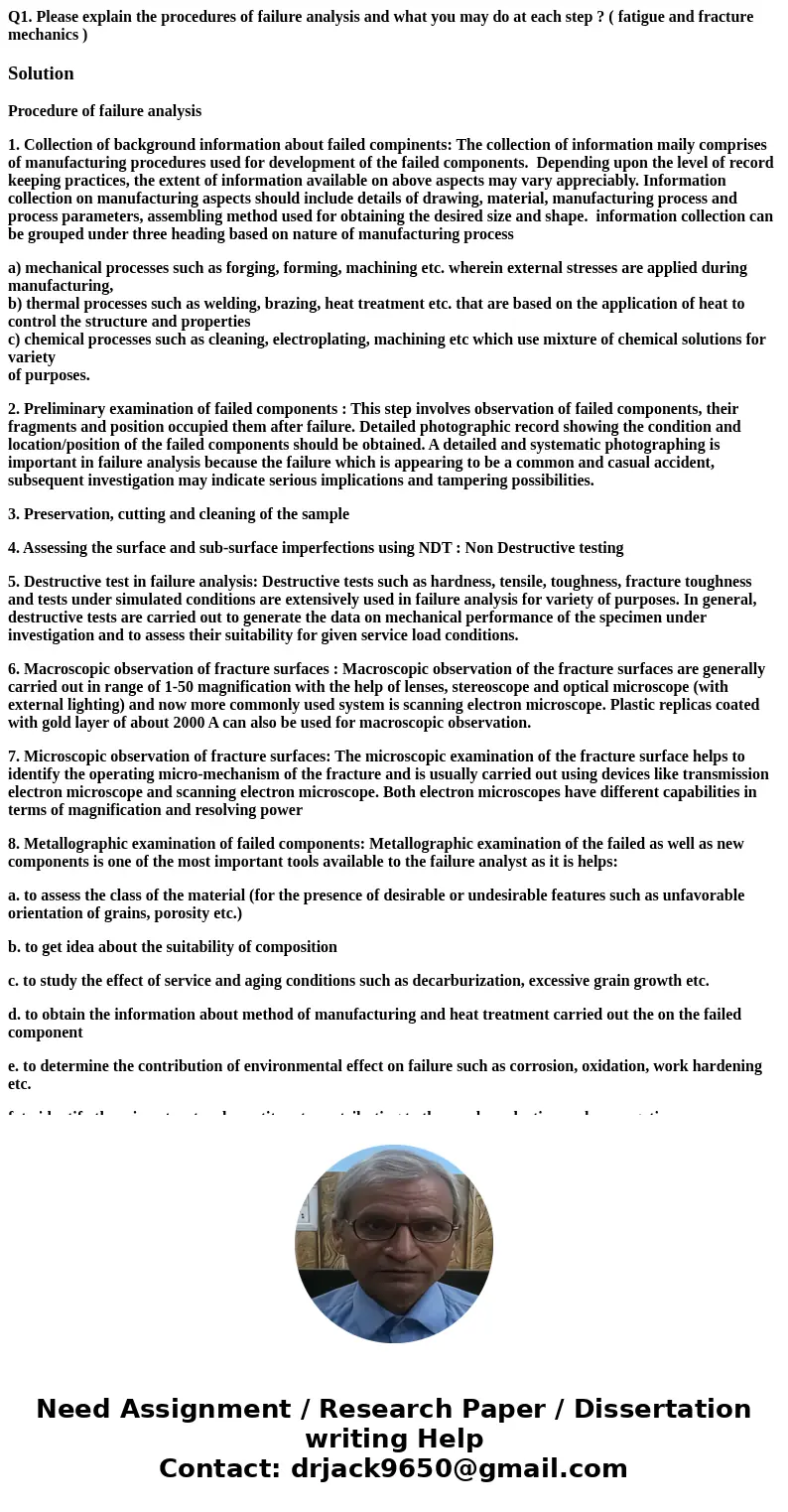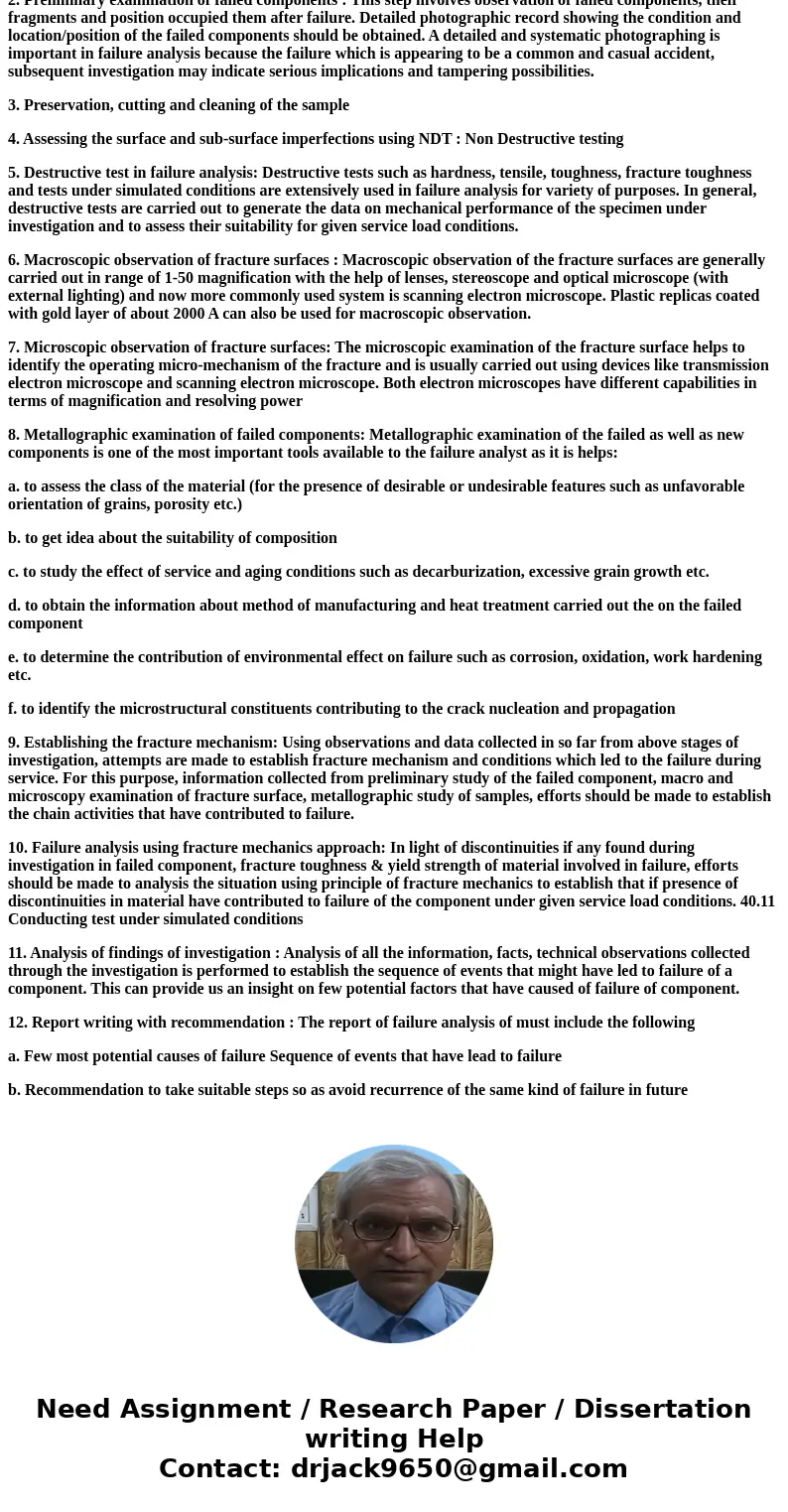Q1 Please explain the procedures of failure analysis and wha
Q1. Please explain the procedures of failure analysis and what you may do at each step ? ( fatigue and fracture mechanics )
Solution
Procedure of failure analysis
1. Collection of background information about failed compinents: The collection of information maily comprises of manufacturing procedures used for development of the failed components. Depending upon the level of record keeping practices, the extent of information available on above aspects may vary appreciably. Information collection on manufacturing aspects should include details of drawing, material, manufacturing process and process parameters, assembling method used for obtaining the desired size and shape. information collection can be grouped under three heading based on nature of manufacturing process
a) mechanical processes such as forging, forming, machining etc. wherein external stresses are applied during manufacturing,
b) thermal processes such as welding, brazing, heat treatment etc. that are based on the application of heat to control the structure and properties
c) chemical processes such as cleaning, electroplating, machining etc which use mixture of chemical solutions for variety
of purposes.
2. Preliminary examination of failed components : This step involves observation of failed components, their fragments and position occupied them after failure. Detailed photographic record showing the condition and location/position of the failed components should be obtained. A detailed and systematic photographing is important in failure analysis because the failure which is appearing to be a common and casual accident, subsequent investigation may indicate serious implications and tampering possibilities.
3. Preservation, cutting and cleaning of the sample
4. Assessing the surface and sub-surface imperfections using NDT : Non Destructive testing
5. Destructive test in failure analysis: Destructive tests such as hardness, tensile, toughness, fracture toughness and tests under simulated conditions are extensively used in failure analysis for variety of purposes. In general, destructive tests are carried out to generate the data on mechanical performance of the specimen under investigation and to assess their suitability for given service load conditions.
6. Macroscopic observation of fracture surfaces : Macroscopic observation of the fracture surfaces are generally carried out in range of 1-50 magnification with the help of lenses, stereoscope and optical microscope (with external lighting) and now more commonly used system is scanning electron microscope. Plastic replicas coated with gold layer of about 2000 A can also be used for macroscopic observation.
7. Microscopic observation of fracture surfaces: The microscopic examination of the fracture surface helps to identify the operating micro-mechanism of the fracture and is usually carried out using devices like transmission electron microscope and scanning electron microscope. Both electron microscopes have different capabilities in terms of magnification and resolving power
8. Metallographic examination of failed components: Metallographic examination of the failed as well as new components is one of the most important tools available to the failure analyst as it is helps:
a. to assess the class of the material (for the presence of desirable or undesirable features such as unfavorable orientation of grains, porosity etc.)
b. to get idea about the suitability of composition
c. to study the effect of service and aging conditions such as decarburization, excessive grain growth etc.
d. to obtain the information about method of manufacturing and heat treatment carried out the on the failed component
e. to determine the contribution of environmental effect on failure such as corrosion, oxidation, work hardening etc.
f. to identify the microstructural constituents contributing to the crack nucleation and propagation
9. Establishing the fracture mechanism: Using observations and data collected in so far from above stages of investigation, attempts are made to establish fracture mechanism and conditions which led to the failure during service. For this purpose, information collected from preliminary study of the failed component, macro and microscopy examination of fracture surface, metallographic study of samples, efforts should be made to establish the chain activities that have contributed to failure.
10. Failure analysis using fracture mechanics approach: In light of discontinuities if any found during investigation in failed component, fracture toughness & yield strength of material involved in failure, efforts should be made to analysis the situation using principle of fracture mechanics to establish that if presence of discontinuities in material have contributed to failure of the component under given service load conditions. 40.11 Conducting test under simulated conditions
11. Analysis of findings of investigation : Analysis of all the information, facts, technical observations collected through the investigation is performed to establish the sequence of events that might have led to failure of a component. This can provide us an insight on few potential factors that have caused of failure of component.
12. Report writing with recommendation : The report of failure analysis of must include the following
a. Few most potential causes of failure Sequence of events that have lead to failure
b. Recommendation to take suitable steps so as avoid recurrence of the same kind of failure in future


 Homework Sourse
Homework Sourse